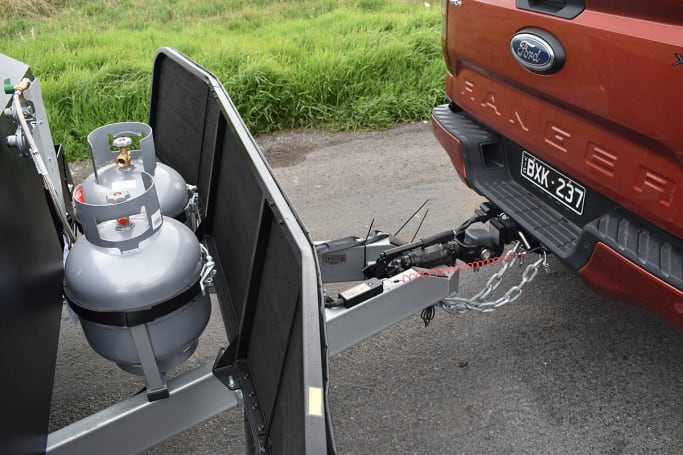
Are wheel spacers legal in Australia?
Are wheel spacers legal in Australia? No, wheel spacers are not legal in...
Browse over 9,000 car reviews

How much does it cost to get a tow bar installed?
It can cost anywhere from $300 to more than $1000 to have a tow bar fitted to your vehicle. Tow bars themselves costs from $200 to beyond $1000.
But equipment cost and fitment cost depend on your vehicle, its towing capacity, the type of towbar you choose, the wiring set-up required and more.
The cheaper you go, the riskier it gets in terms of build quality and after-sales service but, having said that, there are tow bar prices, tow bar types and installation companies to suit every budget.
In very basic terms, a towbar is a device attached to the chassis of a vehicle for the purposes of towing a trailer, caravan, camper-trailer, horse float etc – but not all at once, obviously.
There are different types for different jobs and loads, from standard or light duty towbars (rated for loads up to 1200kg) through to heavy-duty kits that are engineered to take on up to 3500kg.
Towbars are designated in three classes – Class 2, Class 3 and Class 4 – according to how much weight they can legally take on.

Class 2 towbars (also called standard or light duty) can carry a load of up to 1200kg and they are the lightest towbar of all the classes. These are suitable for teardrop trailers and small box trailers, those kinds of loads.
Class 3 towbars (also called medium duty) can legally cope with a load of up to 1600kg. These are suited to tow large box trailers, camper-trailers etc.
Class 4 towbars (also called heavy duty) can legally handle loads of up to 3500kg. These are engineered to cope with big burdens, such as large caravans, horse floats, boats etc.
Tow bar prices can be a bit of a toss-up.
Depending on the type of towbar you opt for, it could cost you anywhere from $200 to $1000 and beyond. Those prices are for the products alone, they do not include fitment.
The cheaper towbars are generally for light-duty purposes, and the more expensive examples are for heavy-duty towing, as sturdier materials are involved in the manufacture of these.

Prices will vary depending on where the towbars are built, the quality of steel used in the manufacture of the towbar, the cost of the production processes involved, and how stringent the quality-control measures are during the manufacture of the towbar.
As mentioned earlier, towbars are classified according to the weight they can legally cope with, but they’re also available in different designs to suit different tasks and stresses.
For the purposes of brevity, though, let’s boil down the options to a fixed hitch (as in bolted or welded to the towbar frame); a removable tongue style; a Euro-style swan neck towbar; and, what you’ll see on many 4WDs and tow vehicles, a 50x50mm hitch receiver with hollow tongue fastened to the hitch receiver by using a hitch pin and R clip.

Your towbar also needs a hitch, which connects the towbar to the trailer/caravan/camper-trailer/horse float. The hitch usually has a standard 50mm tow ball on a rigid ball mount.
Popular in the 4WDing world are off-road couplings (also called articulating hitches), which can rotate up to 360 degrees.
Depending on the type of vehicle and the type of towbar to be fitted, installation may be a DIY job – only if you’re very handy with the tools and are certain your work won’t affect the warranty of either the vehicle or towbar – or, better still, get a professional to install your towbar.
The rear bumper, tail-lights and any other bits that may obstruct towbar installation and, if so, will have to be removed while work is being done. Also, the bumper, exhaust shield (underbody) and other components may have to be cut to make way for the towbar.

The towbar will have to be positioned and bolted to the chassis, then the trailer wiring, including the harness, will have to be installed.
Then it’s time to throw the bumper back on (well, don’t throw it – refit it, properly in place).
Sorting out the wiring might just be the most difficult part of the process – well, it is for me – but companies, such as Hayman Reese, have tackled this issues by developing plug-in wiring solutions to minimise the fuss and streamline the process.
Towing bar installation cost can range anywhere from $300 to more than $1000 to have a tow bar fitted to your vehicle.
Towbar fitting cost will depend on the towbar’s load-rating and the type of vehicle it’s being fitted to. The complexity of the task – whether it will involve cutting the bumper and special wiring – will also impact the towbar fitting price.

As with the price of the towbars and towbar kits, a tow bar installation price can vary depending on labour costs and how difficult the job actually is.
It also depends where you reside in Australia but, don’t fret, because there are respected purveyors of towbars and towbar-fitting specialists everywhere including Adelaide, Brisbane, Melbourne, Sydney, Perth, Canberra and Newcastle.
Comments